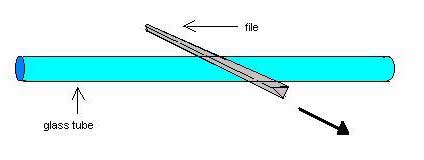 |
 Safety Emporium is a proud sponsor of this site. |
 |
Home Page --> Tutorial Lesson 6, Cutting Glass
|
| Tutorial Lesson 6, Cutting Glass | |
|---|---|
| Lesson 5 (Burners and Torches) |
Lesson 7 (Rotating Glass) |
Cutting Glass
The first two methods listed here work well for smaller diameter rod and tubing. For larger diameters consider methods 3 and 4 will almost certainly be required.
Option #1 - Scratch On The Bench Then Snap
- Create a scratch on the glass wall surface by drawing the corner of a file or, ideally, a tungsten carbide knife perpendicularly across the tube. as shown below:

Tip: Do this step once creating a scratch approximately 1/8 inch long. Do not saw the glass. Sawing the glass will not make the process of breaking the glass any easier. It is not necessary to make a long scratch. A short, single sharp scratch is more likely to produce a clean and even edge. 
- Pick up the glass tube and wet (water, saliva) the scratch with your finger. Turn the scratch away from your body.
- Place your thumbs on the glass tube. The scratch should be located between the thumbs but on the opposite side of the tube as shown below. With practice you will find a distance between your thumbs that works for you.
- Push your thumbs away from you. The glass tube should break cleanly at the scratch. Safety Note: You may wish to wear work (not latex!) gloves or wrap the glass in a towel to reduce the possibility of cutting yourself.

Option #2 - Scratch While Holding Then Snap
- Hold the glass tubing one hand.
- Hold your tungsten carbide knife in a vertical position with other hand. Place the glass tubing between your thumb and knife, holding it firmly - horizontal and close to your body for support and stability.
- Twist the hand with knife, creating your scratch.
- Break the tubing as described in Option #1, Step 4 (above).
Option #3 - Scratch and Apply Hot Glass
- Scratch the tubing with a file or carbide knife as described in Options #1 and #2 (above).
- As above, wet the scratch.
- Heat the end of a 6 mm rod until it is red hot. Quickly place the end of the hot rod onto the wet scratch. Be sure the scratch line extends beyond the contact area of the hot rod.
| Tip: If done correctly, you will observe a crack forming at and extending from the scratch. If the crack does not travel completely around the circumference tap the crack lightly. This action may chase the crack around the tube. Alternatively, reheat the glass rod and reapply to the crack. Again, be sure the rod does not extend beyond the end of the crack. |

Option #4 - Power Tools
Option #5 - Hot Wire Cutter
Disclaimer: Glassblowing has inherent hazards that can result in burns, cuts, injuries or even death. While every effort has been made to convey best safety practices, the materials presented herein can not anticipate every possible risk or hazard associated with a given glassblowing activity. The reader is responsibile for assessing and mitigating any and all such hazards or risks before commencing any activity connected with his or her use of these materials. Neither the author nor ILPI assumes responsibility or liability for injuries, losses, claims or damages to the reader or other parties that may result from the use or misuse of these materials.
by Joe Walas and/or ILPI, all rights reserved unless otherwise stated. Unauthorized duplication or posting on other web sites is expressly prohibited. Send suggestions and comments (include the URL if applicable) to us by email.